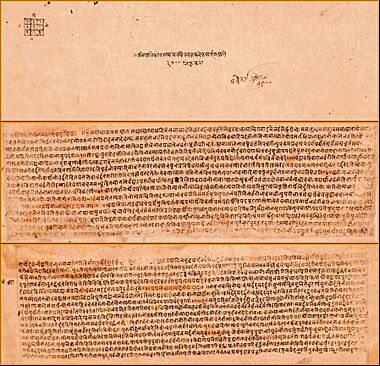Nirukta facts for kids

| Hindu texts |
| Śruti
Smriti |
Nirukta (Sanskrit: निरुक्त, meaning "explained" or "interpreted") is one of the six ancient Vedangas. Vedangas are like helper sciences that go along with the Vedas. The Vedas are very old holy books of Hinduism. Nirukta is all about etymology, which is the study of where words come from and how their meanings have changed. It helps people understand the old Sanskrit words found in the Vedas.
Nirukta is like creating a special dictionary for old, unusual words. This study became important because about a quarter of the words in the Vedic texts, written thousands of years ago, only appear once! This made them hard to understand.
Contents
What is Nirukta?
Nirukta is a special way of studying words. It helps us figure out the true meaning of words, especially very old ones that are not used anymore. Imagine trying to read a book from hundreds of years ago, and some words just don't make sense. Nirukta helps solve that puzzle.
The Vedic texts, written around 2000 BCE, have many such words. About 25% of the words in these texts appear only once. By 1000 BCE, understanding the Vedas was a big challenge. Nirukta tried to create rules for how words are formed. Then it helped figure out their meanings to understand the Vedas better.
When did Nirukta begin?
People started studying Nirukta a very long time ago. We can trace it back to the last few centuries of the 2nd millennium BCE. This was during the time when the Brahmanas part of the Vedic texts was being written.
The most famous scholar in this field was Yaska. He wrote the Nighaṇṭu, which was a book of old words. His main text is also simply called Nirukta. Experts believe Yaska lived between 700 and 500 BCE, even before Gautama Buddha.
Nirukta and Vyakarana
The study of Nirukta is closely linked to another Vedic science called Vyakarana. But they have different goals. Vyakarana looks at how words are put together correctly to express ideas. Think of it as grammar.
Nirukta, on the other hand, focuses on figuring out the correct meaning of words. It looks at how words are used in different situations. Yaska said that you need to study Vyakarana first before you can truly understand Nirukta.
Understanding Words
Yaska, who lived a long time ago, solved the problem of understanding old words. He did this by breaking words down into their smaller parts. Then he looked at how these parts were used in the sentence. This way, he could guess what the old words might have meant. This method is called semantic analysis.
Don't just memorize, try to understand!
If you learn something but don't understand it,
it's like just saying words from memory.
It won't truly help you, like dry wood without fire.
Many people see words but don't truly understand them.
Many hear words but don't really listen.
But for those who seek, understanding reveals itself,
like a wife showing her true self to her husband.
The real meaning of words is their fruit and flower.— Yaska, Nirukta 1.18-1.20
Yaska believed that people often create new words to describe actions. This means that many nouns (names of things) come from verbs (action words). However, he also said that not all words come from verbs. He taught that the meaning of words always depends on how and where they are used.
According to Nirukta scholars, a sentence is a group of words. A word is a group of sounds. To understand old Vedic passages, you need to look at:
- The situation (context)
- The main goal of the text
- What topic is being discussed
- What is being said
- How it is said
- Where it is said
- When it was said
Main Texts of Nirukta
The most important text about Nirukta that still exists today is the one by Yaska. It is simply called Nirukta. There are also three bhasyas (commentaries) that explain Yaska's Nirukta.
There is also an older book called the Nighantu. This book is a list of words found in the Vedas. It's like a glossary, but not a dictionary. Dictionaries, called Koshas, came much later. Yaska's Nirukta often refers to the Nighantu.
The three commentaries on Yaska's Nirukta were written by:
- Durgasinha (or Durga), who lived before the 6th century CE.
- Skanda-Mahesvara, who might be two scholars from before the 5th century CE.
- Nilakantha, who probably lived in the 14th century.
How Nirukta was Used
Ancient Times
Yaska said that the Rigveda, another ancient Vedic text, could be understood in three main ways:
- From the view of religious ceremonies (adhiyajna)
- From the view of the gods (adhidevata)
- From the view of the soul (adhyatman)
Later, a fourth way of understanding the Rigveda appeared. This way saw the gods as symbols for famous people or stories. People generally believed that poets often put hidden meanings, missing words, and new ideas into their writings to inspire readers. Nirukta helps us find these different meanings that writers might have hidden in old texts.
Medieval Times
Nirukta was also used in later times, like by the scholar Bhaskararaya. He used it in his writings to explain things in clever ways. For example, when explaining a name for the god Ganesha, Gaṇanātha, he showed how it could have a deeper meaning than just "Protector of the Ganas (groups)". He used Nirukta to show that it could also mean "the one whose qualities bring good luck when counted." This showed his skill in understanding words in many ways.
See also
- Cratylus (dialogue)
- Folk etymology


